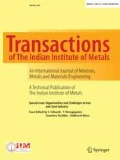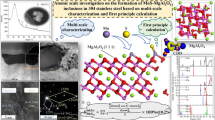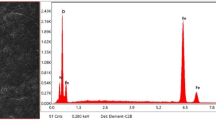Abstract
Ferrite (δ) in two-phase austenite–ferrite Fe–Cr–Ni alloys decomposes into Mo- and Cr-rich phases like sigma (σ) and chi (χ), when aged in the temperature range of 873–1273 K (600–1000 °C). The precipitation of these phases for a particular Fe-Cr-Ni alloy has an adverse effect on its mechanical properties and corrosion resistance. In the present work, precipitation behavior of UNS S32205 duplex stainless steel (a Fe–Cr–Ni alloy) during controlled cooling and heating (isothermal aging) has been studied in the temperature range of 973–1073 K (700–800 °C). Scanning electron microscope (SEM), X-ray diffraction (XRD), electron backscattered diffraction (EBSD) and energy-dispersive spectrometer (EDS) attached to SEM were used to characterize the microstructures. The effect of precipitation of σ and χ phases on the micro-hardness was also studied. The precipitation sequence for 1023 K (750 °C), when cooled from 12,000 to 5 °C/min, was δ → carbides → χ → σ, while for 1073 K (800 °C), it was found to be δ → χ → σ. The Mo-enriched metastable χ phase nucleates at the initial stage of aging which then transforms to stable σ precipitates. The amount of σ and χ phases increased with temperature and aging time, but temperature was found to have a dominant role than the cooling rate due to higher diffusion of solute atoms at high temperatures. EBSD studies did not show any orientation relationship between parent δ ferrite and σ phase.










Similar content being viewed by others
References
Gunn R, Duplex Stainless Steels: Microstructure, Properties and Applications, Abington Publishing, Cambridge (1997) p 219.
Alvarez-Armas I, and Degallaix-Moreuil S, Duplex Stainless Steels, Wiley, Hoboken (2009).
Nilsson J O, Mater Sci Technol8 (1992) 685.
Pramanik A, and Basak A K, Stainless Steel: Microstructure, Mechanical Properties and Methods of Application, Nova Science Publishers, Hauppauge (2015).
Kumar A, Khatirkar R K, Chalapathi D, Kumar G, Suwas S, Metall Mater Trans A48 (2017) 2349.
Kumar A, Khatirkar R K, Gupta A, Shekhawat S K, and Suwas S, Metall Mater Trans A49 (2018) 3402.
Sudhahar M, Mariappan R, and Revanth C, J Chem Pharm Sci9 (2016) 958.
Shamanth V, Ravishankar K S, and Hemanth K, Stainless Steels and Alloys, IntechOpen, London (2012) p 71.
Kumar A, Gupta A, Khatirkar RK, Bibhanshu N, and Suwas S, ISIJ Int58 (2018) 1840.
Kashiwar A, Vennela N P, Kamath S L, and Khatirkar R K, Mater Charact74 (2012) 55.
Chen T H, and Yang J R, Mater Sci Eng A311 (2001) 28.
Escriba D M, Materna-Morris E, Plaut R L, and Padilha A F, Mater Charact60 (2009) 1214.
Pohl M, Storz O, and Glogowski T, Mater Charact58 (2007) 65.
Michalska J, and Sozańska M, Mater Charact56 (2006) 355.
Sato Y S, and Kokawa H, Scr Mater40 (1999) 659.
Gregori A, and Nilsson J O, Metall Mater Trans A Phys Metall Mater Sci33 (2002) 1009.
Chen T H, Weng K L, and Yang J R, Mater Sci Eng A338 (2002) 259.
Glogowski T, Pohl M, and Storz O, Int J Mater Res99 (2008) 1163.
Hsieh C-C, and Wu W, ISRN Metall2012 (2012) 1. https://doi.org/10.5402/2012/732471.
Devine T M, J Electrochem Soc126 (2006) 374.
Adhe K N, Kain V, Madangopal K, and Gadiyar H S, J Mater Eng Perform5 (1996) 500.
Berecz T, and Szabó P J, Period Polytech Mech Eng49 (2005) 123.
Lee K M, Cho H, and Choi D C, J Alloys Compd285 (1999) 156.
Stradomski Z, and Dyja D, 4th Youth Symp Exp Solid Mech (2009) p 17.
Pérez A F M, Breda M, Calliari I, Medina G Y P, and Sandström R, Soldag Insp21 (2016) 165.
Calliari I, Ramous E, Rebuffi G, and Straffelini G, Metall Ital100 (2008) 5.
Okafor I C I, and Carlson O N, Metall Trans A9 (1978) 1651.
Goldschmidt H J, Interstitial Alloys, Butterworth & Co. Publishers Ltd., London (1969).
Lewis M H, Acta Metall14 (1966) 1421.
Atamert S, and King J E, J Mater Sci Lett12 (1993) 1144.
Knyazeva M, and Pohl M, Metallogr Microstruct Anal2(2013) 113.
Calliari I, Zanesco M, Ramous E, and Bassani P, J Mater Eng Perform16 (2007) 109.
Premachandra K, Cartie M B, and Eric R H, Mater Sci Technol8 (2014) 437.
Calliari I, Ramous E, and Bassani P, Mater Sci Forum638–642 (2010) 2986.
Sieurin H, and Sandström R, Mater Sci Eng A444 (2007) 271.
Reick W, Padilha A F, and Pohl M, ISIJ Int38 (1998) 567.
Baldwin W, and Vander Voort G F, Metallography and Microstructures Handbook, vol 9, ASM International, Cleveland (2004) p 2733.
OIM Analysis version: 7.2, User Man. TexSEM Lab. Inc. (2013).
Schwartz A J, Kumar M, Adams B L, Field D P, El-Dasher B, and Deal A, Electron Backscatter Diffraction in Materials Science, Springer, Berlin (2009).
Waanders F B, Vorster S W, and Pollak H, Hyperfine Interact120–121 (1999) 751.
Chan K, and Tjong S, Materials (Basel)7 (2014) 5268.
Tehovnik F, Arzenšek B, Arh B, Skobir D, Pirnar B, and Žužek B, Mater Technol45 (2011) 339.
Badji R, Bouabdallah M, Bacroix B, Kahloun C, Bettahar K, and Kherrouba N, Mater Sci Eng A496 (2008) 447.
Shek C H, Lai J, and Duggan B J, Mater Sci Technol10 (2014) 306.
Souza C M Jr, Abreu H F G, Tavares S S M, Rebello J M A, Mater Charact59 (2008) 1301–1306.
Acknowledgements
The authors are thankful to the Chancellor, VIT-AP University, and the Director, VNIT Nagpur, for their constant encouragement to publish this paper. The authors would also like to acknowledge the use of ‘National Facility of Texture & OIM (a DST-IRPHA facility)’ for EBSD measurements and Centre of Excellence for Steel Technology (CoEST), IIT Bombay, for the use of the dilatometer.
Author information
Authors and Affiliations
Corresponding author
Additional information
Publisher's Note
Springer Nature remains neutral with regard to jurisdictional claims in published maps and institutional affiliations.
Rights and permissions
About this article
Cite this article
Kumar, A., Londhe, S., Dandekar, T. et al. Effect of Cooling Rate on the Precipitation Behavior of a Fe–Cr–Ni Alloy. Trans Indian Inst Met 73, 1961–1973 (2020). https://doi.org/10.1007/s12666-020-02011-w
Received:
Accepted:
Published:
Issue Date:
DOI: https://doi.org/10.1007/s12666-020-02011-w




